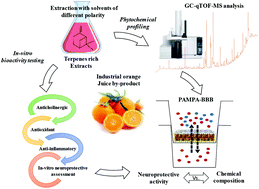In vitro neuroprotective potential of terpenes from industrial orange juice by-products
Abstract
Citrus sinensis (orange) by-products represent one of the most abundant citric residues from orange juice industrial production, and are a promising source of health-promoting compounds like terpenes. In this work, different extraction solvents have been employed to increase terpene extraction yield and selectivity from this orange juice by-product. A set of bioactivity assays including enzymatic (acetylcholinesterase (AChE), butylcholinesterase (BChE) and lipoxygenase (LOX)) as well as antioxidant (ABTS, reactive oxygen species (ROS) and reactive nitrogen species (RNS)) activity tests have been applied to investigate the neuroprotective potential of these compounds. New fluorescence-based methodologies were developed for AChE and BChE assays to overcome the drawbacks of these tests when used in vitro to determine the anticholinergic activity of colored extracts. Comprehensive phytochemical profiling based on gas chromatography coupled to quadrupole time of flight mass spectrometry (GC-qTOF-MS) analysis showed ahigh content of mono- and sesquiterpenes in the extracts obtained with ethyl acetate, whereas n-heptane extracts exhibited a large amount of triterpenes and carotenoids. From a neuroprotective activity point of view, ethyl acetate extract is the most promising due to its anticholinergic activity and antioxidant capacity. Finally, a multivariate data analysis revealed a good correlation between some monoterpenes (e.g. nerol or limonene) and the antioxidant capacity of the natural extract, while a group of sesquiterpenes (e.g. δ-Cadinene or nootkatone) showed correlation with the observed AChE, BChE and LOX inhibition capacity. Hydrocarbons mono- and sesquiterpenoids reveal high capacity in vitro to cross the blood–brain barrier (BBB).



 Please wait while we load your content...
Please wait while we load your content...